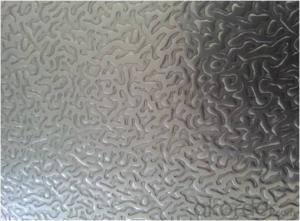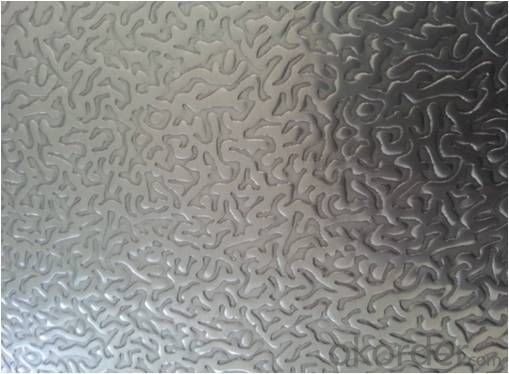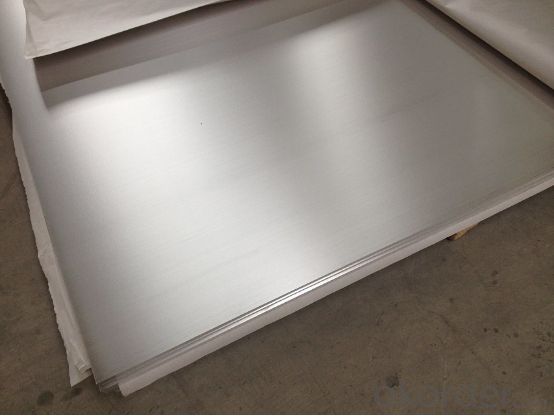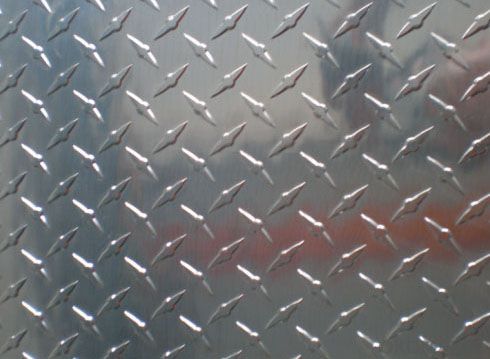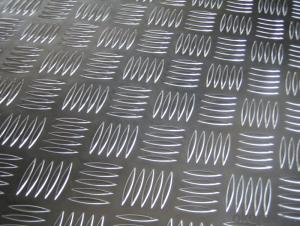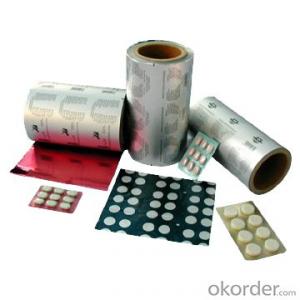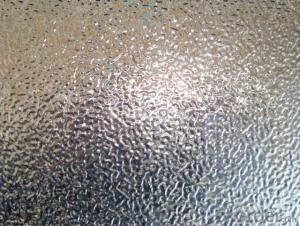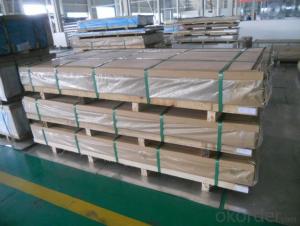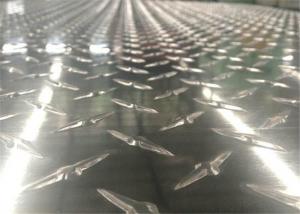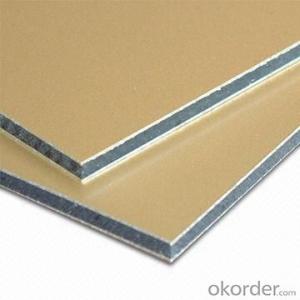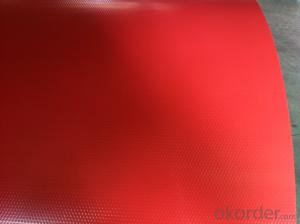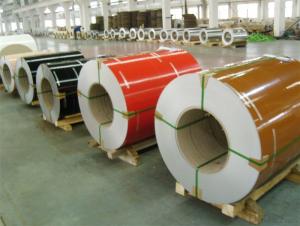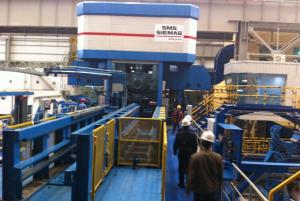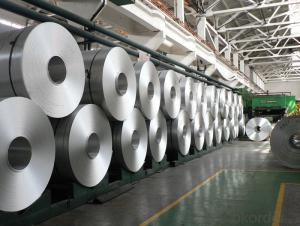Aluminum Diamond Plate Sheets 4x8 - Orange Peel Pattern Aluminum Sheet Coil Plate
- Loading Port:
- Shanghai
- Payment Terms:
- TT OR LC
- Min Order Qty:
- 5 m.t.
- Supply Capability:
- 20000 m.t./month
OKorder Service Pledge
OKorder Financial Service
You Might Also Like
Specification
Common Aluminum Sheet Coil
1. Place of Origin: ZheJiang, China (Mainland)
2. Model Number: 1050/1060/3003/3004/5052/8011
3. Thickness: 0.20-20.0 mm
4. Width: 1000-1700 mm
Packaging & Delivery
1. Coating: Wooden Pallet for Exporting
2. Delivery Detail: 25-30 Days
Specifications
Aluminum Sheet
1. Alloy: 3003A1050/1060/3003/3004/5052/8011
3. Thickness (mm): 0.20-20.0
4. Width (mm): 1000 mm to 170 0mm, Customer Specific Width
5. Finish: Mill, Customer Specific Finish
Our main products are aluminum alloy thick sheet
PS/CTP plate (1050)
anodic oxidation / 3003/5052 (1060/1070)
automotive aluminum alloy (5754/6111/6061)
soldering material (3003/4004)
IT used materials (3003/5052)
the LED base material, material can (3004/3104)
the tank cover and TAB (5052/5182)
aluminous model with substrate (1100)
medicinal foil (8011)
household foil aluminum foil (1235) (8011)
Car Industry:
Alloy: 5182、5083、5754、5052、5042、6061、6063、6082
Feature: nice appearance, good formability, high safety factor, paint hardening effect is significant.
Product Name | Alloy | Usage |
Automotive sheet: interior panels | 1*** 3*** 5*** | Cars, automotive structural components |
Automotive sheet: structure | 1*** 3*** 5*** 6*** | Cars, automotive structural components |
Automotive sheet: housing,auto body | 3*** 5*** 6*** | Cars, automotive structural components |
Transportation Industry
Alloy: 1060、3003、5052、5754、5083、4104、6061、6016, etc..
Feature: High strength, excellent resistance to stress corrosion and welding performance.
Product Name | Alloy | Usage |
Coal car sheet | 1*** 3*** 5*** | Transporter application areas: coal car plate |
Thick aluminum sheet | 1*** 3*** 5*** 6*** | In industrial applications, such as aluminum cans tanker, auto body outer and inner plates |
Brazing sheet | 4*** composite panels | Oxygen equipment and automotive radiator |
Embossed aluminum sheet | 1*** 3*** 5*** | Nonslip floor decoration; nonslip floor; inside the vehicle with the non-slip floor |
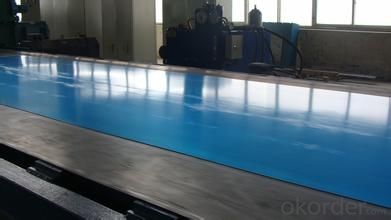
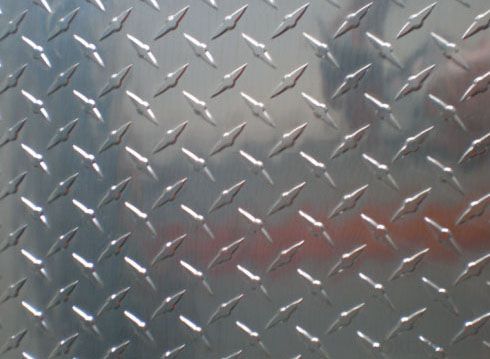
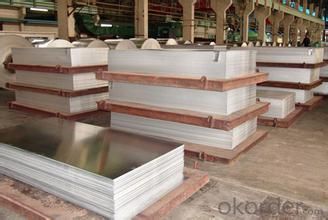
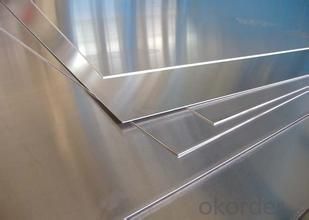
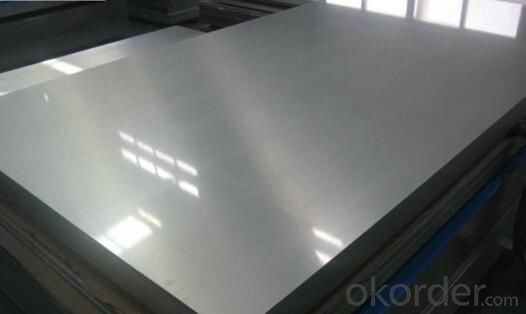
- Q: Can aluminum sheets be used in electrical applications?
- Aluminum sheets have the capability to be employed in electrical applications. Due to its adeptness in conducting electricity, aluminum is frequently utilized in diverse electrical components and applications. In power transmission lines, bus bars, and electrical enclosures, aluminum sheets are frequently employed as conductive materials. Moreover, their exceptional thermal conductivity properties make them valuable in the production of capacitors, transformers, and heat sinks. Furthermore, aluminum sheets are lightweight and resistant to corrosion, rendering them appropriate for electrical applications where weight and durability are crucial considerations.
- Q: Hi everyone, I have this problem that I'm somewhat confused about. The problem is:An alloy of aluminum and magensium was treated with sodium hydroxide solution, in which only aluminum reacts to give hydrogen gas:2Al + 2NaOH + 6H20 --gt; 2NaAl(OH)4 + 3H2If a sample of alloy weighing 1.118 g gave 0.1068 g of hydrogen, what is the percentage aluminum in the alloy?How do I account for the magnesium and what stoichiometric relationships would I need to set-up? This is very confusing, but I appreciate the slightest of help on this!Thank you.
- You don't need to worry about the magnesium at all, because it doesn't enter into the reaction. You have a balanced equation for aluminium and hydrogen, and the data given are sufficient: From the equation, you know that 2 moles of aluminium produce 3 moles of H2. 0.1068 g of H2 were produced, so divide this by molecular mass of H2 (2.016) to determine the moles of H2 produced. You know that 3 moles of H2 would have been produced from 2 moles of Al. Therefore, multiply the moles of H2 by 2/3, to determine the moles of Al that were present. Now multiply this number by the atomic mass of Al, to determine the grams of Al. Now divide this number if grams by 1.118 and multiply by 100 to determine % Al present in the alloy.
- Q: How do aluminum sheets perform in terms of dimensional stability?
- Aluminum sheets generally exhibit good dimensional stability due to their low coefficient of thermal expansion, meaning they are less likely to warp or deform when exposed to temperature changes compared to other materials.
- Q: What are the common uses of aluminum sheets?
- Aluminum sheets possess excellent properties, rendering them highly versatile and extensively utilized across various industries. Their applications encompass: 1. Construction: In the construction industry, aluminum sheets find common usage for roofing, siding, and insulation purposes. Their lightweight nature, durability, and resistance to corrosion make them ideal for shielding against the elements. 2. Transportation: The automotive and aerospace industries heavily rely on aluminum sheets. These sheets contribute to the manufacturing of car bodies, truck trailers, and aircraft parts owing to their impressive strength-to-weight ratio. Consequently, the utilization of aluminum sheets aids in enhancing fuel efficiency and reducing overall vehicle weight. 3. Packaging: Aluminum sheets serve as a popular choice for packaging purposes, specifically within the food and beverage industry. Cans, foils, and containers are frequently crafted from aluminum sheets, as they effectively safeguard packaged products by acting as barriers against moisture, light, and oxygen. 4. Electrical and Electronics: The electrical and electronics industry benefits from the application of aluminum sheets due to their exceptional conductivity. Their utilization extends to the manufacturing of electrical enclosures, heat sinks, and wiring, as they efficiently dissipate heat and protect delicate electronic components. 5. Marine Industry: Aluminum sheets hold significant value within the marine industry due to their resistance to corrosion. They are employed in the construction of boat hulls, ship fittings, and other marine equipment. The ability of aluminum sheets to withstand harsh marine environments, alongside their lightweight properties, renders them an appealing choice. 6. Decorative Applications: Architectural applications often feature aluminum sheets for their aesthetic appeal. These sheets can be effortlessly shaped, formed, and colored to create diverse decorative elements like wall cladding, ceilings, and decorative panels. In conclusion, aluminum sheets serve as a fundamental material across numerous industries, including construction, transportation, packaging, electrical and electronics, marine, and decorative applications. Their versatility and significance are evident in their widespread utilization throughout various sectors.
- Q: I'm making a project for class and I bought a 10 Inch long 5mm thick aluminum/metal, How do you cut it WITHOUT large machinery? is there any power tools adapters or tools that can do this job without a problem?Here is what I have to do:*Cut the metal into ~1x1 and 2X2inch squares*Somehow shave a circle about 2mm deep without going trough the 5mm aluminum (Shaded gray)*Drill a hole right through the 5mm (right in the center)*Drill screw holes on each cornerI provided a really basic pic of what I'm trying to dohttp://img204.imageshack.us/img204/487/77845398.pngRED=backgroundGRAY=drilled 2mm deep WITHOUT GOING THROUGHRED HOLES=screw holes with threadsPlz help need to finish this by friday!PS: Screw holes, and other sizes don't matter right now I'm just trying to figure out what tools/tool adapters I need thanks!
- Steel scissors and Portable hand drill.
- Q: Can aluminum sheets handle high temperatures?
- Yes, aluminum sheets can handle high temperatures. Aluminum has a high melting point of 1220°F (660°C) and excellent heat transfer properties, making it suitable for various applications that involve exposure to high temperatures.
- Q: How are aluminum sheets measured and specified?
- Aluminum sheets are typically measured and specified based on their thickness, width, and length. The thickness is commonly expressed in gauge or millimeters, while the width and length are provided in inches or millimeters. Additionally, the alloy composition and temper of the aluminum sheet may also be specified to meet specific requirements.
- Q: How do aluminum sheets perform in terms of impact resistance?
- Aluminum sheets are renowned for their exceptional ability to withstand impacts. Their high strength-to-weight ratio ensures that they can endure significant forces without deformation or breakage, making them an optimal choice for industries like construction, automotive, and aerospace that require protection against impacts. The remarkable impact resistance of aluminum can be attributed to its inherent toughness. It possesses the capability to absorb and distribute energy from impacts, allowing it to withstand sudden forces and shocks. Moreover, aluminum's capacity to elastically deform enables it to absorb energy through bending and flexing, thereby minimizing the impact's impact on the material. Moreover, the impact resistance of aluminum sheets can be further enhanced through various techniques, including alloying and heat treatment. By alloying aluminum with elements like copper, manganese, or magnesium, its strength and impact resistance can be improved, resulting in a more robust alloy. Additionally, heat treatment processes like tempering or annealing can refine the microstructure of aluminum, thus enhancing its mechanical properties and impact resistance. In conclusion, aluminum sheets possess exceptional impact resistance due to their high strength-to-weight ratio, inherent toughness, and elastic deformability. Through advancements in alloying and heat treatment techniques, the impact resistance of aluminum sheets can be further enhanced to meet the specific requirements of diverse industries.
- Q: What is the typical thermal conductivity of aluminum sheets?
- Aluminum sheets usually exhibit a thermal conductivity ranging from 205 to 230 watts per meter-kelvin (W/mK). Thanks to this remarkable thermal conductivity, aluminum serves as an exceptional conductor of heat. Hence, it finds widespread usage in various applications that prioritize efficient heat transfer, including heat sinks, power transmission lines, and cooking utensils.
- Q: I am looking to purchase a pressure cooker and the size that i want comes in aluminum while alot of the others are made from stainless steel. I am wondering if the metal makes a difference in the funtionality and if one doesn't stand up as well as the other.
- Aluminum Pressure Cooker
Send your message to us
Aluminum Diamond Plate Sheets 4x8 - Orange Peel Pattern Aluminum Sheet Coil Plate
- Loading Port:
- Shanghai
- Payment Terms:
- TT OR LC
- Min Order Qty:
- 5 m.t.
- Supply Capability:
- 20000 m.t./month
OKorder Service Pledge
OKorder Financial Service
Similar products
Hot products
Hot Searches
Related keywords
